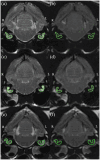Suppression of inner ear signal intensity on fluid-attenuated inversion recovery magnetic resonance imaging in cats with vestibular disease
- PMID: 37102785
- PMCID: PMC10811974
- DOI: 10.1177/1098612X231168001
Suppression of inner ear signal intensity on fluid-attenuated inversion recovery magnetic resonance imaging in cats with vestibular disease
Abstract
Objectives: Otitis media/interna (OMI) is the most common cause of peripheral vestibular disease in cats. The inner ear contains endolymph and perilymph, with perilymph being very similar in composition to cerebrospinal fluid (CSF). As a very-low-protein fluid, it would be expected that normal perilymph should suppress on fluid-attenuated inversion recovery (FLAIR) MRI sequences. Based on this, we hypothesized that MRI FLAIR sequences should provide a non-invasive way of diagnosing inflammatory/infectious diseases such as OMI in cats, something that has previously been demonstrated in humans and, more recently, in dogs.
Methods: This was a retrospective cohort study in which 41 cats met the inclusion criteria. They were placed into one of four groups, based on presenting complaint: clinical OMI (group A); inflammatory central nervous system (CNS) disease (group B); non-inflammatory structural disease (group C); and normal brain MRI (control group; group D). Transverse T2-weighted and FLAIR MRI sequences at the level of the inner ears bilaterally were compared in each group. The inner ear was selected as a region of interest using Horos, with a FLAIR suppression ratio calculated to account for variability in signal intensity between MRIs. This FLAIR suppression ratio was then compared between groups. Statistical analyses were performed by an experienced statistician, with a general linear model used to compare mean FLAIR suppression ratio, CSF nucleated cell count and CSF protein concentration between groups.
Results: The OMI group (group A) had significantly lower FLAIR suppression scores compared with all other groups. The CSF cell count was also significantly increased in the OMI (group A) and inflammatory CNS disease (group B) groups compared with the control group (group D).
Conclusions and relevance: This study demonstrates the utility of MRI FLAIR sequences in diagnosing presumptive OMI in cats, similarly to in humans and dogs. This study is relevant to practicing veterinary neurologists and radiologists in interpreting MRI findings in cats with suspected OMI.
Keywords: FLAIR; MRI; neuroimaging; neurology; otitis; radiology; vestibular.
Conflict of interest statement
The authors declared no potential conflicts of interest with respect to the research, authorship, and/or publication of this article.
Figures




Similar articles
-
Inner ear fluid-attenuated inversion recovery MRI signal intensity in dogs with vestibular disease.Vet Radiol Ultrasound. 2020 Sep;61(5):531-539. doi: 10.1111/vru.12876. Epub 2020 Jun 20. Vet Radiol Ultrasound. 2020. PMID: 32564460
-
Unilateral decrease in inner ear signal in fluid-attenuated inversion recovery sequences in previously suspected canine idiopathic vestibular syndrome.Vet J. 2021 Nov;277:105748. doi: 10.1016/j.tvjl.2021.105748. Epub 2021 Sep 16. Vet J. 2021. PMID: 34537343
-
Abrogation of fluid suppression in intracranial postcontrast fluid-attenuated inversion recovery magnetic resonance imaging: A clinical and phantom study.Vet Radiol Ultrasound. 2018 Jul;59(4):432-443. doi: 10.1111/vru.12605. Epub 2018 Feb 8. Vet Radiol Ultrasound. 2018. PMID: 29424062 Free PMC article.
-
Optimal sequences and sequence parameters for GBCA-enhanced MRI of the glymphatic system: a systematic literature review.Acta Radiol. 2021 Oct;62(10):1324-1332. doi: 10.1177/0284185120969950. Epub 2020 Nov 5. Acta Radiol. 2021. PMID: 33153270
-
Diagnostic imaging of the canine and feline ear.Vet Clin North Am Small Anim Pract. 2004 Mar;34(2):437-58. doi: 10.1016/j.cvsm.2003.10.013. Vet Clin North Am Small Anim Pract. 2004. PMID: 15062618 Review.
References
-
- DeLahunta A, Glass E, Kent M. Vestibular system: special proproception. In: DeLahunta A, Glass E, Kent M. (eds). De Lahunta’s veterinary neuroanatomy and clinical neurology. Philadelphia, PA: Elsevier, 2021, pp 345–373.
-
- Uemura EE. Vestibular system. In: Uemura EE. (ed). Fundamentals of canine neuroanatomy and neurophysiology. New York, NY: Wiley-Blackwell, 2015, pp 307–328.
-
- Naganawa S, Satake H, Iwano S, et al.. Communication between cochlear perilymph and cerebrospinal fluid through the cochlear modiolus visualized after intratympanic administration of Gd-DTPA. Radiat Med 2008; 26: 597–602. - PubMed
MeSH terms
LinkOut - more resources
Full Text Sources
Research Materials
Miscellaneous

